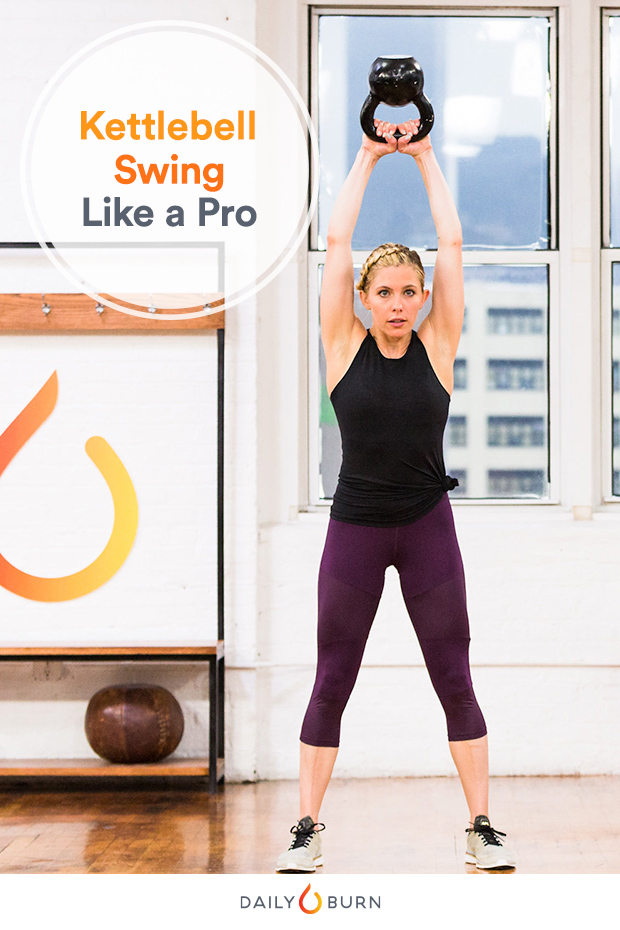
Whether you’re flying solo at the gym or are into group fitness classes, chances are you’ve come across a kettlebell or two. From your glutes and back to your quads, arms and core, there are countless ways to get a total-body workout with a kettlebell.
Jaclyn Emerick, fitness director at Shape magazine, certified personal trainer and recent guest on Daily Burn 365, says that training with kettlebells amps up your power-endurance, forcing your muscles to contract faster. This translates to a higher calorie burn and, over time, greater lean muscle mass. Plus, because the kettlebell’s weight isn’t as balanced as it is in dumbbells or body bars, your body has to work harder to stabilize and find your center of gravity.
“Kettlebells make for a great one-and-done workout, meaning you get your cardio and strength training knocked out in the same session,” Emerick says.
RELATED: 5 Kettlebell Mistakes (And How to Fix Them)
Choosing the Right Kettlebell Weight
Before getting started, you might have to crunch some numbers first. Kettlebells come in kilograms, not in pounds (one kg is equivalent to 2.25 lbs). And because most kettlebell movements are dynamic, you can stand to pick up something heavier than you would with a dumbbell.
According to Daily Burn kettlebell expert, Cody Storey, women might want to start with 8 kg (18 lbs) or 12 kg (26 lbs), and men with 16 kg (35 lbs). As you get stronger, you can increase in weight. Or, follow Emerick’s lead and choose a weight you can swing for 30, 45 or 60 seconds that leaves you completely breathless by the end of the set. If you feel like you could swing for another 5 or 10 seconds, try a heavier bell.
Breaking Down the Kettlebell Swing
While the kettlebell can be utilized for many of the same exercises as the dumbbell, there’s one move you simply can’t replicate with another tool. We’re talking about the kettlebell swing. Nailing it can be tough, though. Here are Emerick’s dos and don’ts for the classic kettlebell exercise.
DO: Stay in neutral.
One of the most common mistakes beginners make is rounding the shoulders and back, Emerick says. Whether you’re doing a simple deadlift or a more advanced single-arm swing, Emerick says, “Keeping a neutral spine will protect your back and ensure that you’re moving properly and safely during a swing. The first step in this progression will help you learn what it feels like to have a neutral spine during a hip hinge movement.”
“There are no squats in a kettlebell swing.”
RELATED: Kettlebells vs. Dumbbells: Which Should I Choose?
DON’T: Get low, get low.
When it comes to the hip thrust, it’s not necessarily about activating certain muscles, but rather about mastering a critical movement pattern for the kettlebell swing, Emerick advises. Just remember: There are no squats in a kettlebell swing.
DO: Power from the hips.
Another kettlebell pitfall is powering through the arms and not the hips. According to Emerick, if you’re doing a kettlebell swing correctly, it should feel like the weight is almost floating to the top of the movement. Pro tip: “Stand a foot behind the kettlebell. That way, when you hinge forward to grab it to swing it back between your legs, you’ll have a little bit of momentum thanks to gravity,” Emerick instructs. “Once you hike the kettlebell through your legs, thrust (or snap) your hips forward as powerfully as you can — don’t be shy — and allow that to almost push the kettlebell forward and up.”
DON’T: Forget your footing.
Be sure to have a stance wide enough to allow the bell to flow freely through your legs and knees. But Emerick warns not to go much wider than that because you can put your knees at risk of injury.
Want more beginner workout tips? Head to DailyBurn.com/365 for expert guidance and a brand new workout every day.
